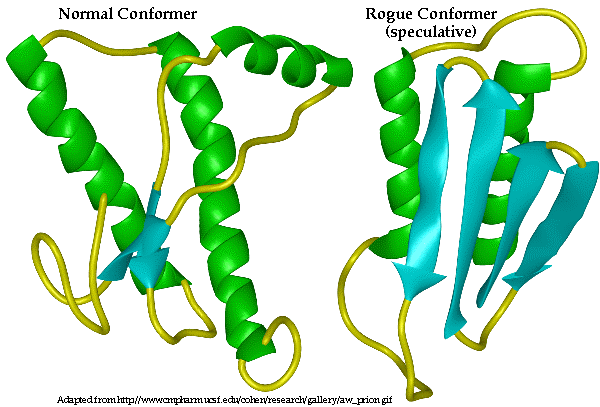The New York Times published the following article about Prusiner at the time he was awarded the Nobel Prize in Medicine:
An intensely single-minded and controversial UC San Francisco medical researcher received the 1997 Nobel Prize in Physiology or Medicine on Monday for discovering an "entirely new genre of disease-causing agents" responsible for exotic brain disorders such as mad cow disease and its human equivalents.
Dr. Stanley B. Prusiner, 55, a neurologist and biochemist, was awarded the prize for his pioneering work on an infectious particle that he named a "prion" in a landmark 1982 study. Way out on an intellectual limb, Prusiner argued that prions break the most basic rules of biology: Unlike bacteria and viruses, a prion (PREE-on) consists only of a protein fragment that manages to reproduce and spread although it has no genetic material of its own, such as DNA.
That "sensational hypothesis," as the Nobel announcement called it, was so unorthodox at the time that it brought Prusiner heavy criticism and even ridicule from fellow scientists, with cruel limericks about "a Young Turk named Stan" circulating among experts.
But in dozens of experiments over the last 15 years, he and his often far-flung co-workers established the existence of prions--and showed that the particles were more paradoxical than originally imagined.
Among other dogma-defying aspects, it turns out that normal human brain cells contain a "healthy" version of prion proteins that can, like Jekyll becoming the evil Hyde, be transformed into a pathological prion. This in turn can give rise to a variety of wasting brain diseases in animals and people. Many researchers believe that Alzheimer's disease, among other nerve disorders, may be caused by a similar mechanism.
The Nobel is Prusiner's "final vindication," said Dr. Daniel Perl, a director of neuropathology at the Mt. Sinai School of Medicine in New York City and an old friend. "He ran into tremendous resistance in the beginning. But the breadth and depth of what he has done and published is monumental."
Prusiner, commenting on the slings and arrows that critics have fired at him over the years, said in a telephone interview Monday that he never considered giving up. "Science is about the systematic collection of data and the interpretation of that data," he said.
"You have to be forceful, you have to be aggressive, you have to be pushy. Nobody does well in science unless he has those traits. I don't know any scientists who don't push, and some push harder than others."
It was the first time in 10 years, and only the fifth time since 1960, that the medical Nobel was awarded to just one person. Prusiner will receive the $1 million that comes with the prize at the ceremony in Stockholm on Dec. 10. He said that he had no plans yet to spend the money other than to pay taxes on it.
"His work has turned a once obscure corner of medicine into an important source of new ideas about fundamental biological mechanisms," said Zach Hall, the director of the National Institute for Neurological Disease and Stroke, which has partially funded Prusiner's research since 1975.
A UC San Francisco co-worker, Fred Cohen, said Prusiner's career is "an example of how perseverance, together with an intense focus on a problem, can lead to results."
Dr. Bruce Miller, a neurologist at the UCLA School of Medicine and an official with the John Douglas French Alzheimer's Foundation, which has supported Prusiner's research, said that initially "almost no one believed [the prion theory] because it went against conventional thinking. But increasingly the scientific community thinks that this model of prion disease has relevance to understanding Alzheimer's and many other degenerative diseases."


6 comments:
Do you think our friends talked to Stanley Prusiner?
"He ran into tremendous resistance in the beginning. But the breadth and depth of what he has done and published is monumental."
Do you think Dr. Prusiner ever had to stand down 10 police officers, 4 FBI agents, -- and getting hauled off to D.C. General for an emergency forensic psychiatric exam?
Probably not!
Roseanne put it best:
Those who can, do. Those who can't, teach. Those who can't teach, teach gym. And those who can't teach gym become experts!
Creative people are crazier and saner than the noncreative:
http://dailstrug.blogspot.com/2010/01/im-crazier-and-saner-than-most-people.html
Characteristics of creative persons:
http://books.google.com/books?id=ZYo5AAAAIAAJ&pg=PA68&lpg=PA68&dq=courage++subjects+%22independence+of+thought+and+judgment+honesty+perseverance%22+creative&source=bl&ots=Oc3mpwMqkg&sig=Qox3gBc8F8b2D-mb6UI5dVpEPEI&hl=en&sa=X&ei=ws4vT6OZG-fz0gGo84TdCg&ved=0CB4Q6AEwAA#v=onepage&q=courage%20%20subjects%20%22independence%20of%20thought%20and%20judgment%20honesty%20perseverance%22%20creative&f=false
Personality profile of Marie Curie, who worked 4 years to prove the existence of a new element, radium.
http://dailstrug.blogspot.com/2011/06/personality-profile-of-person-who.html
Post a Comment